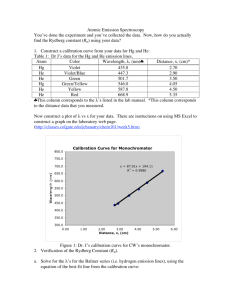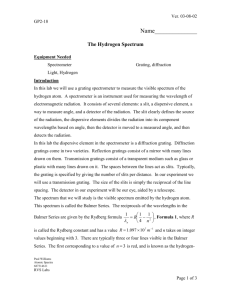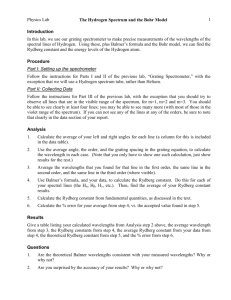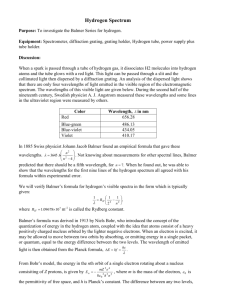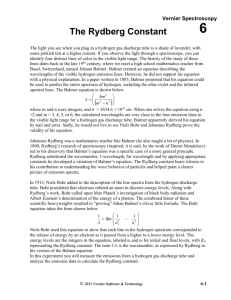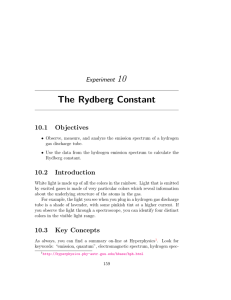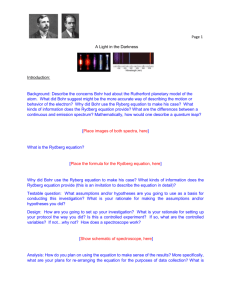Rydberg Constant & Hydrogen Spectrum Lab: High School Physics
advertisement
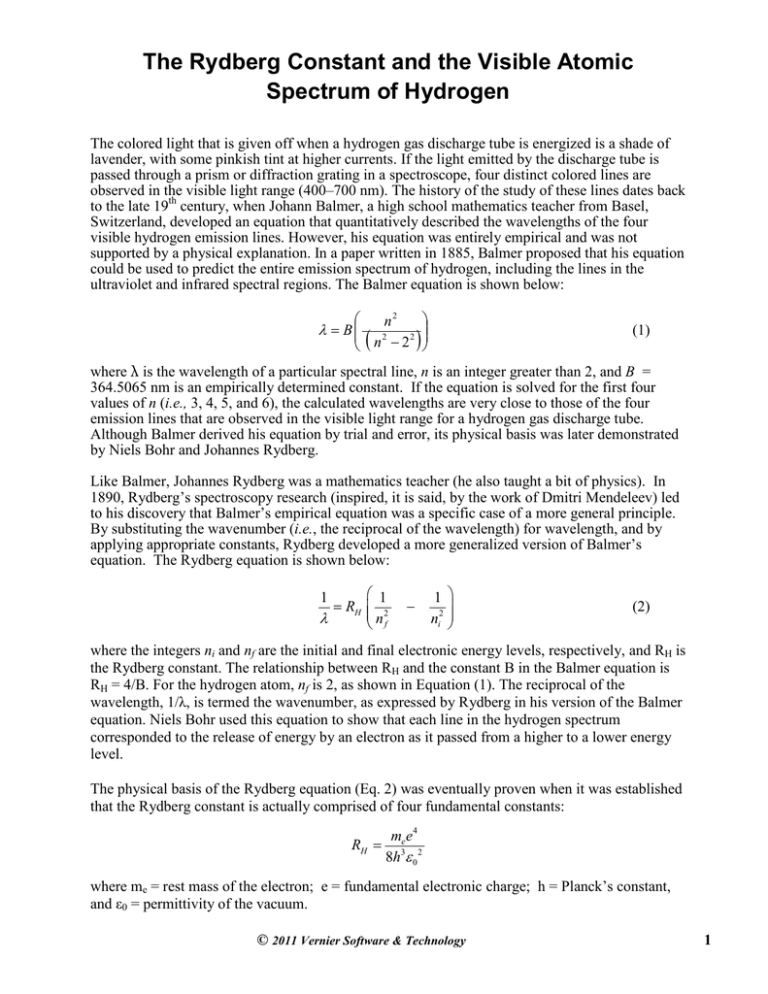
The Rydberg Constant and the Visible Atomic Spectrum of Hydrogen The colored light that is given off when a hydrogen gas discharge tube is energized is a shade of lavender, with some pinkish tint at higher currents. If the light emitted by the discharge tube is passed through a prism or diffraction grating in a spectroscope, four distinct colored lines are observed in the visible light range (400–700 nm). The history of the study of these lines dates back to the late 19th century, when Johann Balmer, a high school mathematics teacher from Basel, Switzerland, developed an equation that quantitatively described the wavelengths of the four visible hydrogen emission lines. However, his equation was entirely empirical and was not supported by a physical explanation. In a paper written in 1885, Balmer proposed that his equation could be used to predict the entire emission spectrum of hydrogen, including the lines in the ultraviolet and infrared spectral regions. The Balmer equation is shown below: n2 2 2 n −2 λ = B ( ) (1) where λ is the wavelength of a particular spectral line, n is an integer greater than 2, and B = 364.5065 nm is an empirically determined constant. If the equation is solved for the first four values of n (i.e., 3, 4, 5, and 6), the calculated wavelengths are very close to those of the four emission lines that are observed in the visible light range for a hydrogen gas discharge tube. Although Balmer derived his equation by trial and error, its physical basis was later demonstrated by Niels Bohr and Johannes Rydberg. Like Balmer, Johannes Rydberg was a mathematics teacher (he also taught a bit of physics). In 1890, Rydberg’s spectroscopy research (inspired, it is said, by the work of Dmitri Mendeleev) led to his discovery that Balmer’s empirical equation was a specific case of a more general principle. By substituting the wavenumber (i.e., the reciprocal of the wavelength) for wavelength, and by applying appropriate constants, Rydberg developed a more generalized version of Balmer’s equation. The Rydberg equation is shown below: 1 1 = RH 2 nf λ − 1 ni2 (2) where the integers ni and nf are the initial and final electronic energy levels, respectively, and RH is the Rydberg constant. The relationship between RH and the constant B in the Balmer equation is RH = 4/B. For the hydrogen atom, nf is 2, as shown in Equation (1). The reciprocal of the wavelength, 1/λ, is termed the wavenumber, as expressed by Rydberg in his version of the Balmer equation. Niels Bohr used this equation to show that each line in the hydrogen spectrum corresponded to the release of energy by an electron as it passed from a higher to a lower energy level. The physical basis of the Rydberg equation (Eq. 2) was eventually proven when it was established that the Rydberg constant is actually comprised of four fundamental constants: RH = me e 4 8h3ε 0 2 where me = rest mass of the electron; e = fundamental electronic charge; h = Planck’s constant, and ε0 = permittivity of the vacuum. © 2011 Vernier Software & Technology 1 Vernier Spectroscopy OBJECTIVES In this experiment, you will • • Measure and analyze the emission spectrum of a hydrogen gas discharge tube. Use the data from the hydrogen emission spectrum to calculate the Rydberg constant. [Note that the gas in the unenergized discharge tube consists of diatomic H2 molecules, not H-atoms. However, application of a high voltage (several hundred volts) to the tube causes the H2 molecules to dissociate into H-atoms and simultaneously excites the single electron in each of the H-atoms into a higher energy level. The light that is observed from the energized discharge tube is emitted when the excited electrons lose energy as they fall back into lower energy levels.] MATERIALS Vernier UV-VIS Spectrophotometer Computer Logger Pro 3 software Optical Fiber accessory Hydrogen gas discharge tube and power supply Pre-Lab Exercise – Working with the Balmer Equation Use the Balmer equation (1), as described in the introduction above, to calculate the four wavelengths in the visible light range for the hydrogen gas emission. Record your calculated results in the data table below. Predict the color expected for each emission line, based on its calculated wavelength. ni nf λ (nm) Color 2 2 2 2 © 2011 Vernier Software & Technology 2 The Rydberg Constant PROCEDURE 1. Always wear safety goggles. 2. The UV-VIS Spectrophotometer should already be set up and prepared for you to use. If it is not, do the following: a. Fully insert the cuvette-shaped end of the black optical fiber assembly into the cuvette holder in the spectrophotometer. The cuvette-shaped sensor is keyed and will fit into the opening in only one orientation. b. Connect the narrow (pink) end of the optical fiber assembly to the holder that is attached to the H2 discharge tube. c. Turn the power switch of the spectrophotometer to the OFF position. d. Connect one end of the USB cable to the spectrophotometer and the other end to a USB port on the computer. 3. Start the Logger Pro 3 data collection program, and choose New from the File menu. 4. To prepare the spectrometer for measuring light emissions, open the Experiment menu and select Change Units ► Spectrometer: 1 ► Intensity. (Intensity is a relative measure, with a range of 0 to 1.) 5. To set an appropriate sampling time for collecting emission data, open the Experiment menu and choose SetUp Sensors ►Spectrometer:1. In the dialog box that appears, make the following settings: Sample Time = 25 ms Wavelength Smoothing = 0 Samples to Average = 1 Wavelength range = 350 to 700 nm. 6. Turn on the hydrogen gas discharge tube. 7. Click the green Collect button at the right end of the toolbar (or press the Space bar) to start data collection. An emission spectrum will immediately be displayed and continuously updated. If necessary, adjust the Sample Time so that the highest peak intensity on the graph stays below 1.0. When you obtain a satisfactory spectrum, click the red Stop button (or press the Space bar) to end data collection. 8. To analyze your emission spectrum graph, click the Examine icon, , on the toolbar in Logger Pro 3. Determine as precisely as possible the wavelengths of each of the four spectral lines in hydrogen’s Balmer series. (A small circle will appear on the moveable vertical cursor line when it is at a peak maximum.) The intensities of the third and fourth peaks (i.e., those having the lowest wavelengths) are very low, but their positions can be more accurately determined by repeating the data collection using a longer Sample Time. (By doing so, you also may be able to detect the fifth peak in the series, which is located at <400 nm.) Record the wavelengths of the four peaks of the spectrum in the data table below. 9. Store the run by choosing Store Latest Run from the Experiment menu in Logger Pro 3. 10. The hydrogen discharge tube has a limited lifetime. Be sure to switch it off after you have completed your data collection. © 2011 Vernier Software & Technology 3 Vernier Spectroscopy DATA TABLE Use your data to complete the table below. You will have determined the wavelengths by examining the graph of the hydrogen discharge tube emissions. Wavelength (nm) Wavenumber –1 (m ) Frequency, ν -1 (s ) Photon Energy (J) ni (Balmer Series) Calculated Rydberg –1 Constant (m ) 3 4 5 6 Calculation Guide • • • • • Wavelength (in nm): examine the graph and record the peaks in the specified regions. Wavenumber (in m-1) = 109/(wavelength in nm) Frequency (ν, in s-1) = c/λ = (3 × 108 m/s) / (wavelength in m) (1 nm = 1 × 10–9 m) –34 2 –1 Photon Energy (in J) = h × ν (h = 6.626 × 10 m ·kg·s ) nf = 2 in all four cases DATA ANALYSIS 1. Use Equation (2) described in the introduction to calculate the Rydberg constant for the four lines in the Balmer Series that you identified in the table above. What is the average value for the Rydberg constant, based on your data? 2. A second method of determining the Rydberg constant is to analyze a graph of wavenumber values vs. n in the Balmer series. Prepare a plot of wavenumber (on the ordinate axis) vs. 1/ni2 (on the abscissa axis). Calculate the best-fit line (linear regression) for the plot. The slope of this line is equal to –RH. What is the relationship of the intercept to RH? 3. The accepted value of the Rydberg constant, RH, is 1.097 × 107 m–1. Compare your calculated value of RH to the accepted value. 4. Use the value of RH that you calculated in Question #3 to predict the wavelength of the fifth line in the Balmer Series (i.e., for ni = 7). Examine the hydrogen emission spectrum that you obtained at the longest Sample Time. Does the fifth Balmer line appear as a peak in your spectrum? Explain. © 2011 Vernier Software & Technology 4
